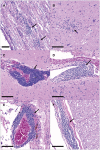A Zika virus primary isolate induces neuroinflammation, compromises the blood-brain barrier and upregulates CXCL12 in adult macaques
- PMID: 32585067
- PMCID: PMC8018016
- DOI: 10.1111/bpa.12873
A Zika virus primary isolate induces neuroinflammation, compromises the blood-brain barrier and upregulates CXCL12 in adult macaques
Abstract
Zika virus (ZIKV) is a flavivirus that can cause neuropathogenesis in adults and fetal neurologic malformation following the infection of pregnant women. We used a nonhuman primate model, the Indian-origin Rhesus macaque (IRM), to gain insight into virus-associated hallmarks of ZIKV-induced adult neuropathology. We find that the virus causes prevalent acute and chronic neuroinflammation and chronic disruption of the blood-brain barrier (BBB) in adult animals. ZIKV infection resulted in specific short- and long-term augmented expression of the chemokine CXCL12 in the central nervous system (CNS)of adult IRMs. Moreover, CXCL12 expression persists long after the initial viral infection is apparently cleared. CXCL12 plays a key role both in regulating lymphocyte trafficking through the BBB to the CNS and in mediating repair of damaged neural tissue including remyelination. Understanding how CXCL12 expression is controlled will likely be of central importance in the definition of ZIKV-associated neuropathology in adults.
Keywords: CXCL12; Zika virus; blood-brain barrier; flavivirus; nonhuman primate.
© 2020 International Society of Neuropathology.
Conflict of interest statement
The authors have no financial or non‐financial competing interests.
Figures




Similar articles
-
Intraamniotic Zika virus inoculation of pregnant rhesus macaques produces fetal neurologic disease.Nat Commun. 2018 Jun 20;9(1):2414. doi: 10.1038/s41467-018-04777-6. Nat Commun. 2018. PMID: 29925843 Free PMC article.
-
Zika Virus Infection Promotes Local Inflammation, Cell Adhesion Molecule Upregulation, and Leukocyte Recruitment at the Blood-Brain Barrier.mBio. 2020 Aug 4;11(4):e01183-20. doi: 10.1128/mBio.01183-20. mBio. 2020. PMID: 32753493 Free PMC article.
-
Using Macaques to Address Critical Questions in Zika Virus Research.Annu Rev Virol. 2019 Sep 29;6(1):481-500. doi: 10.1146/annurev-virology-092818-015732. Epub 2019 Jun 10. Annu Rev Virol. 2019. PMID: 31180813 Free PMC article. Review.
-
Antiviral CD8 T cells induce Zika-virus-associated paralysis in mice.Nat Microbiol. 2018 Feb;3(2):141-147. doi: 10.1038/s41564-017-0060-z. Epub 2017 Nov 20. Nat Microbiol. 2018. PMID: 29158604 Free PMC article.
-
Exploring Zika Virus Impact on Endothelial Permeability: Insights into Transcytosis Mechanisms and Vascular Leakage.Viruses. 2024 Apr 18;16(4):629. doi: 10.3390/v16040629. Viruses. 2024. PMID: 38675970 Free PMC article. Review.
Cited by
-
The CXCL12/CXCR4/ACKR3 Response Axis in Chronic Neurodegenerative Disorders of the Central Nervous System: Therapeutic Target and Biomarker.Cell Mol Neurobiol. 2022 Oct;42(7):2147-2156. doi: 10.1007/s10571-021-01115-1. Epub 2021 Jun 12. Cell Mol Neurobiol. 2022. PMID: 34117967 Free PMC article. Review.
-
Nonhuman Primates in Translational Research.Annu Rev Anim Biosci. 2022 Feb 15;10:441-468. doi: 10.1146/annurev-animal-021419-083813. Annu Rev Anim Biosci. 2022. PMID: 35167321 Free PMC article. Review.
-
Immunological imbalance in microcephalic children with congenital Zika virus syndrome.Med Microbiol Immunol. 2022 Dec;211(5-6):219-235. doi: 10.1007/s00430-022-00746-5. Epub 2022 Jul 20. Med Microbiol Immunol. 2022. PMID: 35857104
-
Zika virus E protein modulates functions of human brain microvascular endothelial cells and astrocytes: implications on blood-brain barrier properties.Front Cell Neurosci. 2023 Jul 20;17:1173120. doi: 10.3389/fncel.2023.1173120. eCollection 2023. Front Cell Neurosci. 2023. PMID: 37545876 Free PMC article.
-
Cohort study: Neurological and cognitive-behavioral sequelae of acquired Zika virus infection among Nicaraguan children.Pediatr Res. 2025 Feb;97(2):687-694. doi: 10.1038/s41390-024-03160-0. Epub 2024 Jul 2. Pediatr Res. 2025. PMID: 38956218 Free PMC article.
References
-
- Al‐Obaidi MMJ, Bahadoran A, Har LS, Mui WS, Rajarajeswaran J, Zandi K et al (2017) Japanese encephalitis virus disrupts blood‐brain barrier and modulates apoptosis proteins in THBMEC cells. Virus Res 233:17–28. - PubMed
-
- Araujo AQ, Silva MT, Araujo AP (2016) Zika virus‐associated neurological disorders: a review. Brain 139(Pt 8):2122–2130. - PubMed
Publication types
MeSH terms
Substances
Grants and funding
LinkOut - more resources
Full Text Sources
Medical

